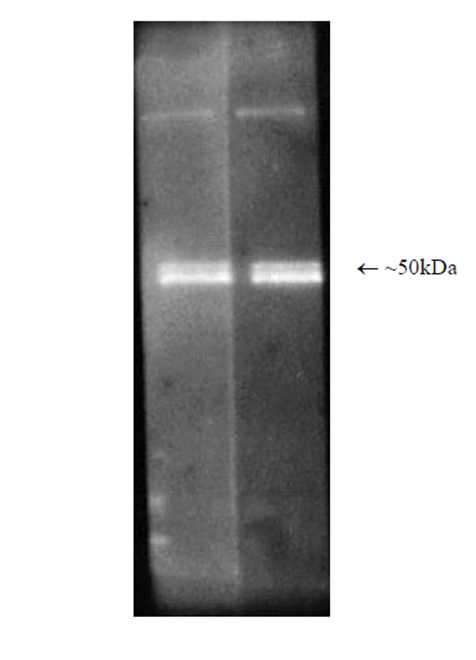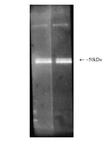Product Details
| Alternative Name: | TBP1, Tat-binding protein 1, 26S protease regulatory subunit 6A, Proteasome 26 S subunit ATPase 3 |
| |
| Clone: | TBP1-19 |
| |
| Host: | Mouse |
| |
| Isotype: | IgG2b |
| |
| Immunogen: | Recombinant full-length human Rpt5. |
| |
| UniProt ID: | P17980 |
| |
| Source: | Purified from hybridoma tissue culture supernatant. |
| |
| Species reactivity: | Human, Mouse, Rat
Rabbit
|
| |
| Specificity: | Recognizes the Rpt5/S6a subunit of the 19S regulatory subunit |
| |
| Applications: | IHC, WB
|
| |
| Purity Detail: | Partially purified ascites. |
| |
| Formulation: | Liquid. Contains 10mM sodium azide. |
| |
| Shipping: | Blue Ice |
| |
| Long Term Storage: | -20°C |
| |
| Scientific Background: | The proteasome is widely recognised as the central enzyme of non-lysosomal protein degradation. It is responsible for intracellular protein turnover and it is also critically involved in many regulatory processes and, in higher eukaryotes, in antigen processing. The 26S proteasome is the key enzyme of the ubiquitin/ATPdependent pathway of protein degradation. The catalytic core of this unusually large (2000kDa, 450Å in length) complex is formed by the 20S proteasome, a barrel shaped structure shown by electron microscopy to comprise of four rings each containing seven subunits. Based on sequence similarity, all fourteen 20S proteasomal subunit sequences may be classified into two groups, α and β, each group having distinct structural and functional roles. The α-subunits comprise the outer rings and the β-subunits the inner rings of the 20S proteasome. Observations of the eukaryotic proteasome and analysis of subunit sequences indicate that each ring contains seven different subunits (α7β7β7α7) with a member of each sub-family represented in each particle. Each subunit is located in a unique position within the α- or β-rings. In addition to the 20S particle, the 26S complex contains over twenty additional proteins, ranging in molecular weight from 25 to 10kDa, located in a distinct complex called the ‘PA700 proteasome activator’ or the ‘19S complex’, and which determines substrate specificity and provides the multiple enzymatic functions necessary for proteolysis and viability. Systematic analysis of the sub-unit components have revealed at least six members to be ATPases belonging to a new family of ATP-binding proteins, together with a further fifteen subunits that lack the capacity to bind ATP, isopeptidases and several other proteins thought to be responsible for the unfolding of a protein substrate prior to insertion into the proteolytic core of the 20S proteasome. |
| |
| Technical Info/Product Notes: | The hybridoma secreting the antibody to subunit Rpt5/S6a was generated by fusion of splenocytes from Balb/c mice that had received repeated immunisation with a full length human recombinant protein with Sp2/0-Ag14 myeloma cells. The antibody (clone TBP1-19) has been characterised by one-dimensional Western blotting.
Immunoblotting - Single dimension SDS-PAGE of a purified rabbit 26S proteasome preparation followed by Western blotting at optimal dilution (1:2500) gives a major band with a relative molecular weight of approximately 50kDa. There is a minor band observed running slightly slower that may be due to modification.
Immunoprecipitation - This antibody has not been characterised for this purpose.
Immunohistochemistry - This antibody has been shown to be suitable for this purpose in the subcellular localisation of proteasomes. |
| |
| Regulatory Status: | RUO - Research Use Only |
| |

Western blot analysis: Luminograph of rabbit 26S proteasome preparation after SDS PAGE followed by blotting onto PVDF membrane and probing with antibody BML-PW8770. Antibody dilution 1:1000 and 1:2500 using ECL procedure (1 min exposure).
Please mouse over
Product Literature References
The Arabidopsis Deubiquitylase OTU5 Suppresses Flowering by Histone Modification-Mediated Activation of the Major Flowering Repressors FLC, MAF4, and MAF5: R. Radjacommare, et al.; Int. J. Mol. Sci.
24, 6176 (2023),
Abstract;
A versatile new tool derived from a bacterial deubiquitylase to detect and purify ubiquitylated substrates and their interacting proteins: M. Zhang, et al.; PLoS Biol.
20, e3001501 (2022),
Abstract;
Phytochrome B triggers light-dependent chromatin remodelling through the PRC2-associated PHD finger protein VIL1: J. Kim, et al.; Nat. Plants
7, 1213 (2021),
Abstract;
Spatial regulation of thermomorphogenesis by HY5 and PIF4 in Arabidopsis: S. Lee, et al.; Nat. Commun.
12, 3656 (2021),
Abstract;
Bortezomib Amplifies Effect on Intracellular Proteasomes by Changing Proteasome Structure: D.S. Pitcher, et al.; EBioMedicine
2, 642 (2015),
Application(s): Western Blot,
Abstract;
Skeletal muscle myotubes in severe obesity exhibit altered ubiquitin-proteasome and autophagic/lysosomal proteolytic flux: L.M. Bollinger, et al.; Obesity (Silver Spring)
23, 1185 (2015),
Application(s): Western Blot,
Abstract;
Full Text
Nuclear proteasomes carry a constitutive posttranslational modification which derails SDS-PAGE (but not CTAB-PAGE): D.S. Pitcher, et al.; Biochim. Biophys. Acta
1844, 2222 (2014),
Abstract;
TRIM5α associates with proteasomal subunits in cells while in complex with HIV-1 virions: Z. Lukic, et al.; Retrovirology
8, 93 (2011),
Abstract;
Full Text












